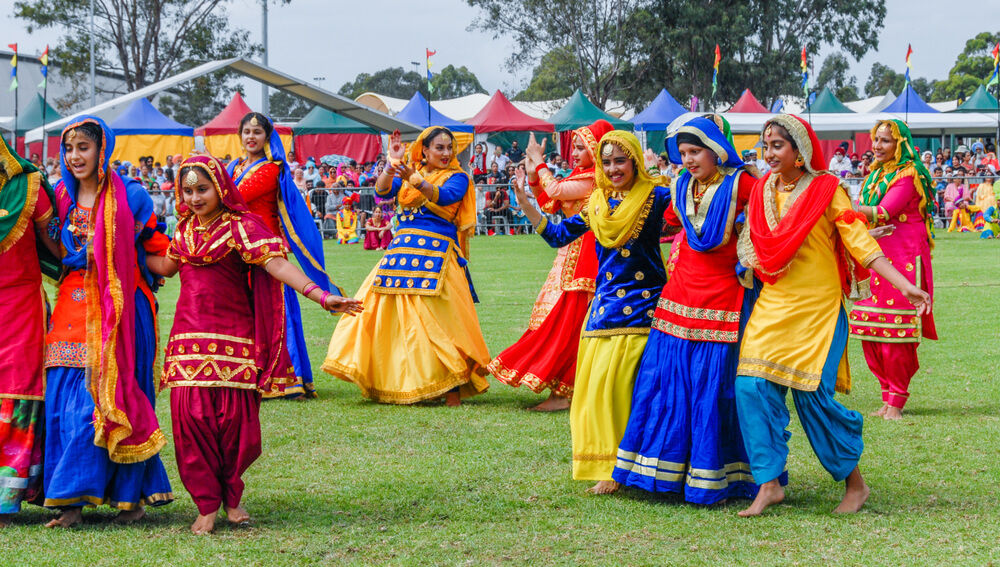In an era defined by relentless globalization and the homogenizing pull of dominant cultures, is the soul of Punjabits ancient history, its intoxicating music, and its lyrical languagedestined to fade into a muted echo of its former glory? Regrettably, the answer leans towards a somber affirmation: a confluence of internal vulnerabilities and external pressures is steadily eroding the very foundations of this historically profound and culturally opulent region, posing a significant threat to its unique identity and enduring legacy.
Punjab, reverently known as the "land of five rivers," lays claim to a civilization that burgeons from the annals of prehistory. This fertile crescent, a land bisected by the border between India and Pakistan, has long functioned as a vibrant melting pot of cultures, a bustling hub for trade, and a hotly contested arena for empires vying for supremacy. The very essence of its name, "Punjab," derived from the Persian lexicon where "panj" signifies "five" and "ab" translates to "water," encapsulates the life-giving force of the regionthe five majestic rivers that irrigate its sprawling lands.
| Punjabi Language and Culture: Key Aspects | |
|---|---|
| Official Status | Official language of the Indian state of Punjab. Also recognized as a scheduled language in India. Widely spoken in Pakistan, where it has no official status but is the most spoken language. |
| Geographic Distribution | Primarily spoken in the Punjab region of India and Pakistan. Significant diaspora communities exist in the UK, Canada, USA, and Australia. |
| Dialects | Numerous dialects, including Majhi, Doabi, Malwi, and Pothohari, among others. |
| Writing Systems | Primarily written in the Gurmukhi script (used in India) and the Shahmukhi script (used in Pakistan). |
| Religion | Punjabi culture is associated with diverse religions. Sikhism is prevalent, especially in Indian Punjab. Islam is predominant in Pakistani Punjab, with significant Hindu and Christian communities. |
| Cultural Significance | Rich traditions of music, dance (Bhangra, Giddha), cuisine, and literature. Punjabi culture is known for its vibrant celebrations and festivals. |
| Threats and Challenges | Language shift towards English in some contexts (employment, education), cultural assimilation in the diaspora, and the impact of globalization. |
| Preservation Efforts | Efforts by individuals, organizations, and governments to promote Punjabi language and culture through education, arts, and media. |
| Related Information | Wikipedia - Punjabi Language |
Despite its deep-rooted history and profound cultural resonance, the Punjabi ethos confronts a phalanx of contemporary challenges, witnessing a gradual diminishment in its sphere of influence and grappling with the ever-encroaching tide of other languages and cultural paradigms. The scenario is intricate, laden with implications that stretch across language preservation, cultural identity, and the very destiny of the Punjabi people. At the heart of this cultural crossroads lies the Punjabi language, a vibrant and indispensable vessel of collective identity, which is now facing multifaceted pressures that threaten its sustained vitality.
- Hdhub4u Unveiled Is Free Movie Bliss Worth The Risk Analysis
- Discover Nagi Hikaru Japans Rising Star In Entertainment
The erosion of the Punjabi language, the very bedrock of cultural expression, manifests in diverse and disquieting ways. Within the hallowed halls of academia, particularly in private educational institutions, and during crucial state employment assessments, there is a discernible bias towards English, sidelining Punjabi to the periphery. This preference for English is echoed in officialdom, where even high-ranking dignitaries, such as the Chief Minister and the Governor of Punjab, have been observed addressing the populace in English, despite the overwhelming majority being native Punjabi speakers.
This insidious marginalization of Punjabi ignites profound anxieties about its future trajectory. Should the language fail to be actively championed and embraced in key societal arenas, it runs the perilous risk of being relegated to a language confined within the domestic sphere, stripped of its vigor and relevance in the broader public discourse. Such a diminishment would inevitably trigger a cascading effect, precipitating a decline in Punjabi literature, music, and other forms of cultural expression, irrevocably scarring the cultural landscape. The potential loss of nuanced literary traditions, the stifling of unique musical voices, and the erosion of diverse artistic perspectives collectively paint a grim picture of cultural impoverishment.
Yet, the indomitable spirit of Punjab, forged in the crucible of history, resists easy subjugation. Across communities, both within the region and among the diaspora, a collective resolve to safeguard and celebrate the language and culture is gaining momentum. Digital platforms and community initiatives are at the vanguard of this movement, breathing new life into traditional forms and fostering intergenerational connections. Websites like elearnpunjabi serve as invaluable resources, offering comprehensive language learning tools and cultural insights for children of Punjabi descent growing up beyond the geographical confines of India, as well as for individuals with a passion to learn the language.
- Hdhub4u Is Free Movie Downloads Worth The Risk What You Need To Know
- What Is Masahub Unveiling The Platform Legit Or Risky
The effervescent music scene of Punjab emerges as another vibrant facet of its cultural identity, with a constellation of artists crafting tracks that resonate deeply with music aficionados, especially those with Punjabi roots. Anthems like "Koka" by Mankirt Aulakh, imbued with lyrics that capture the contemporary experiences of the Punjabi diaspora, stand as poignant testaments to the enduring potency of music as a unifying cultural force. These contemporary musical narratives, blending tradition with modernity, serve as powerful vehicles for preserving and promoting cultural values across generations.
The proliferation of digital platforms, most notably YouTube, has proven instrumental in disseminating Punjabi music to a global audience. Artists adeptly leverage these platforms to forge connections with their listeners, generously sharing original compositions and engaging content. This digital outreach dramatically amplifies the reach and influence of Punjabi music, transforming it from a regional soundscape to a global phenomenon. The accessibility afforded by these platforms empowers artists to bypass traditional gatekeepers, fostering a more democratic and inclusive cultural ecosystem.
The continuous evolution of Punjabi music is exemplified by recent releases such as "Lahore" by Gulab Sidhu, seamlessly weaving traditional elements with contemporary sounds and thematic explorations. The widespread popularity of these songs serves as a compelling indicator of the enduring allure of Punjabi music, demonstrating its capacity to adapt and resonate with diverse audiences while remaining true to its cultural core. This dynamic interplay between tradition and innovation ensures that Punjabi music remains both relevant and representative of the evolving cultural landscape.
The Punjabi diaspora constitutes a vital lifeline in the preservation of the language and culture. Spanning continents, from the United Kingdom and Canada to the United States and Australia, Punjabi communities actively celebrate their shared heritage through a variety of initiatives. These include the establishment of community organizations, cultural centers, and educational programs meticulously designed to promote the Punjabi language, music, dance, and traditions. These communal spaces serve as vital hubs for cultural transmission, ensuring that the legacy of Punjab endures across generations.
These diasporic communities frequently orchestrate cultural events, ranging from soul-stirring music concerts and mesmerizing dance performances to vibrant festivals, all aimed at celebrating the rich tapestry of Punjabi heritage. These gatherings not only fortify community bonds and cultivate a sense of belonging but also provide invaluable opportunities for younger generations to connect with their cultural roots. Furthermore, numerous diasporic communities actively facilitate Punjabi language classes, empowering their members to maintain linguistic fluency and ensure the intergenerational transmission of their mother tongue.
The digital realm has emerged as a potent ally in the mission to promote Punjabi language and culture. A burgeoning array of online resources dedicated to Punjabi has taken shape, including comprehensive dictionaries, user-friendly language-learning apps, and immersive websites showcasing Punjabi literature, music, and films. Social media platforms have become vital tools for artists, writers, and community groups to engage with their audiences, disseminate their creative endeavors, and stimulate conversations surrounding Punjabi culture.
Moreover, online libraries offer unrestricted access to vast collections of Punjabi books in diverse formats, including downloadable PDFs, convenient ebooks, and engaging audio recordings. This digital accessibility enables individuals from all corners of the globe to explore Punjabi literature and culture, regardless of their geographical location. The ready availability of these online resources plays an indispensable role in ensuring that Punjabi remains accessible to a global audience, providing a gateway for anyone seeking to deepen their understanding of this vibrant cultural heritage.
The presence of both the Gurmukhi and Shahmukhi scripts in written Punjabi introduces a distinctive linguistic dichotomy. Gurmukhi, predominantly employed in India, carries strong associations with Sikhism and is widely regarded as the standardized script for Punjabi. Shahmukhi, conversely, finds its primary usage in Pakistan and represents a modification of the Perso-Arabic script. Comprehending the nuances and historical contexts underpinning these scripts is crucial for appreciating the full spectrum of Punjabi literature and culture.
The intricate tapestry of dialects woven within the Punjabi language further enhances its richness and complexity. From the melodious strains of Majhi to the robust intonations of Malwi and the subtle inflections of Doabi and Pothohari, each dialect narrates a unique story, reflecting the diverse cultural landscapes and historical trajectories of the region. Delving into the nuances of these dialects unlocks a deeper understanding of Punjabi heritage, illuminating the multifaceted identities and experiences embedded within the language. Moreover, it enriches the communicative landscape of the language by facilitating diverse avenues of self-expression.
The enduring allure of Punjabi music transcends geographical boundaries, captivating listeners worldwide with its infectious rhythms and soul-stirring melodies. The exuberant energy of Bhangra, the soulful introspection of Sufi music, and the lyrical narratives of contemporary tracks collectively embody the Punjabi spirit, crafting a rich and resonant soundscape that appeals to a diverse range of tastes and backgrounds. This universal appeal of Punjabi music underscores its capacity to connect people across cultures and generations, fostering a shared appreciation for its cultural significance.
The continuous creation of new Punjabi songs keeps the music scene alive and vibrant. Each year witnesses the release of a plethora of new songs, with the latest offerings of 2023 swiftly climbing the charts and captivating audiences. The prominent presence of Punjabi music on digital platforms and streaming services, such as YouTube, Spotify, and Apple Music, underscores its extensive reach and enduring cultural significance. These platforms provide Punjabi artists with unprecedented opportunities to reach global audiences, fostering a dynamic and interconnected music ecosystem.
The unwavering commitment of Punjabi artists to remain true to their cultural roots while embracing contemporary styles ensures that Punjabi music remains dynamic and relevant in a rapidly evolving world. By venturing into uncharted musical territories and collaborating with artists from diverse backgrounds, these musicians contribute to the creation of a vibrant cultural scene that draws inspiration from both heritage and modernity. This fusion of tradition and innovation allows Punjabi music to resonate with audiences across generations and cultural boundaries, solidifying its place as a global cultural force.
The profound cultural exchange between India and Pakistan, fueled by the shared history and heritage of the Punjabi people, cannot be overstated. Despite the enduring political divisions, the cultural bonds uniting Punjabi communities on both sides of the border remain remarkably resilient. This shared heritage permeates language, traditions, and music, forging a sense of unity that transcends geographical boundaries.
Cultural exchange programs, artistic collaborations, and people-to-people interactions play a crucial role in fostering mutual understanding and preserving this invaluable common heritage. By promoting respect and appreciation for shared cultural traditions, these initiatives bolster the continuity of cultural ties and encourage dialogue between communities separated by political borders. These cross-border interactions serve as vital bridges, fostering empathy and understanding while preserving the shared cultural legacy of the Punjabi people.
The story of Punjab is a testament to resilience, diversity, and an unwavering commitment to cultural preservation. While formidable challenges persist, the Punjabi people are actively engaged in safeguarding their language and culture through a multifaceted approach that encompasses community initiatives, digital innovation, and artistic expression. This collective dedication ensures that the cultural legacy of Punjab continues to flourish, enriching the lives of present and future generations.
This discourse has illuminated various facets of Punjabi culture, underscoring its rich history, the profound influence of language and music, the persistent challenges, and the ongoing endeavors to preserve its cultural heritage. These elements converge to paint a compelling portrait of the Punjabi people, showcasing their enduring spirit and the dynamic interplay between cultural identity and globalization. The narrative of Punjab serves as a powerful reminder of the importance of cultural preservation in an increasingly interconnected world.
- Hikaru Nagi The Rising Star And Her Impact On Jentertainment
- Ullu App Bold Content Amp 18 Web Series Niche New Releases


